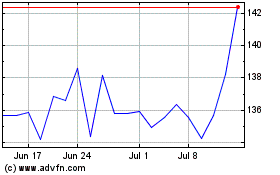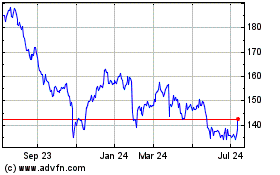UPS Tests a 3-D Printing Service and Delivery Business
September 18 2015 - 7:54PM
Dow Jones News
By Lindsay Ellis And Laura Stevens
At its hub in Louisville, Ky., United Parcel Service Inc.
recently rolled out 100 industrial-grade 3-D printers to make
everything from iPhone gizmos to airplane parts.
UPS wants to find out if 3-D printing centers could shorten
supply chains and cut into its $58 billion-a-year transportation
business--or give it a leg up in a potentially emerging market for
local production and delivery.
For Atlanta-based UPS, the difference could be existential. It
doesn't want 3-D printing to disrupt its business the way the
Internet pulled the rug out from overnight document deliveries more
than a decade ago.
"Should we be threatened by it or should we endorse it?" asked
Dave Barnes, UPS's chief information officer, during a recent
presentation to employees and customers. "We saw the capability of
a logistics company to be challenged on one side but on the other
be an enabler."
Its 3-D project is run by an Atlanta startup called CloudDDM LLC
that UPS invested in last year. The two companies plan to expand
next year with another 900 printers, and are discussing opening
similar print factories outside the U.S.
The technology slices a digital image of an object into
thousands of layers, which printers then recreate one at a time in
plastic, metal or other materials. It has attracted investments
from companies like jet-engine maker General Electric Co. and
appliance giant Whirlpool Corp. So far, the 3-D printing industry
hasn't lived up to the hype, constrained by slow print speeds,
small sizes and rapid technology change.
Sales in the 3-D printing industry have risen about 34% annually
for the past three years, and acquisitions in the industry have
totaled more than $468 million in the past five years, according to
data firm Dealogic.
UPS isn't the only delivery company exploring the printing
business. TNT Express NV, a Dutch parcel-delivery company in the
process of being acquired by FedEx, earlier this year started
printing services at some locations across Germany and struck a
partnership with a printing firm to expand options for customers.
FedEx Corp. says it is examining the field, while Amazon.com Inc.
has filed a patent for a 3-D printing truck, aimed at creating an
on-demand system printing goods from inside delivery vehicles.
Deutsche Post AG's DHL recently looked at all products being
shipped from Asia to Europe and concluded that only between 2% and
4% of those could be 3-D printed. It also asked employees to hand
over objects for replication, and determined that only 10% of those
objects--including a baby shoe and a foosball table player--could
be reproduced with full functionality.
"We see a risk, but not for the mass of products," said Markus
Kückelhaus, DHL's 3-D expert who leads the company's trend research
team. While there may be opportunity in producing spare parts, Mr.
Kückelhaus said printing speed and product liability remain
deterrents. "We don't need to be scared of this technology," he
said.
UPS expects more companies will migrate some production to 3-D
printing from traditional manufacturing on an aggressive growth
curve, according to Rimas Kapeskas, head of UPS's strategic
enterprise fund. And UPS is also talking with customers about
taking on a bigger role as a light manufacturer using 3-D
printers.
Last year, UPS invested an undisclosed sum to take a minority
stake in CloudDDM, which in May launched full operations of its
printers at the delivery company's supply chain campus, something
the startup describes as a "critical element" of its business plan.
It prints the items and UPS ships them out to customers for quick
delivery.
Late last month, the operation received an order for 40 mounting
brackets for paper towel dispensers from a division of
Georgia-Pacific LLC that makes dispensers, Dixie cups and cutlery.
CloudDDM printed the mounts and UPS shipped them to a
Georgia-Pacific engineer by the next morning. The brackets were
slated for a month-long "stress test," said Michael Dunn, the
senior vice president of innovation development for
Georgia-Pacific.
Whirlpool turned to the operation recently when its own 3-D
printers were all occupied. The maker of Maytag and KitchenAid
products uses the printing method for prototypes of items like
trays for refrigerators and venting systems for dryers, as a way to
test parts on smaller scale.
"The quicker you can get a prototype back into the engineering
team's hands, the faster they can respond" to problems, said
Michael Cukier, a Whirlpool principal engineer.
In Louisville, UPS has used its own service. The company needed
to develop a replacement floor beam support bracket for its fleet
of Airbus A300 aircraft, which are out-of-production.
The part helps containers filled with packages easily move on
and off the plane. CloudDDM printers made the part within hours and
walked it across the runway for testing in a UPS plane.
Write to Laura Stevens at laura.stevens@wsj.com
(END) Dow Jones Newswires
September 18, 2015 19:39 ET (23:39 GMT)
Copyright (c) 2015 Dow Jones & Company, Inc.
United Parcel Service (NYSE:UPS)
Historical Stock Chart
From Mar 2024 to Apr 2024

United Parcel Service (NYSE:UPS)
Historical Stock Chart
From Apr 2023 to Apr 2024
